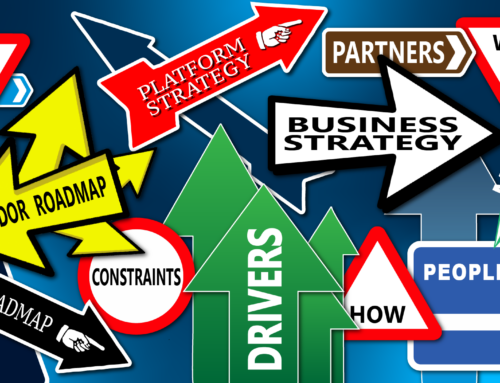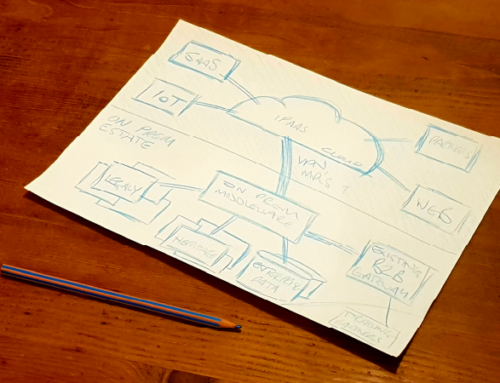Unfortunately, IT demand is notoriously difficult to plan, particularly for fast-moving industries where the business priorities change on almost a daily basis. The tendency is for IT teams to oversimplify or inwardly focus their demand management process because painting a more accurate picture is a complicated affair. The impact of this is that IT is either grossly over or undermanned to deal with the incoming challenges and is viewed either as an overblown and expensive department full of geeks twiddling their thumbs or, as incompetent butterflies who are always working on the wrong things and never getting the important stuff done.
For teams dealing with Integration, this impact can be even worse because they are typically responding to multiple project demands, which often emerge late, in an already uncertain landscape and balancing the priorities in an already complex context.
It is time to embrace the uncertainty and tackle the issue! Depending on how your IT teams are managing integration requirements (either your IT teams manage their own integration points, or you have a centralised COE) there will be different demand challenges and solutions for cutting through the chaos and regaining control of the beast.
The answer is a mixture of science, enquiry and persistence. If you understand the drivers, find the sources of information and stick close to them and then use simple measures to track and tweak the effectiveness of your team you can smooth out the picture.
We’ll discuss some of the challenges where individual IT teams manage their own integration points in a future article but in this blog post we will highlight some of the demand challenges for the integration centre of excellence.
The challenges

1. The IT plan keeps changing
Every time you make a plan it changes so IT managers tend not to update their expected dates on the planning system as it seems to be a waste of time until you get a confirmed set of requirements in your hand.
- The Integration Demand Manager needs to be proactive in finding out the truth if it isn’t available on the official system. Run your own plan if necessary, make it highly visible and simple for stakeholders to understand. We’ve seen very effective plans using post-it notes pinned to a fibre board. Walk it round with you and use it in your discussions with the responsible project managers and plan based on what they say, not necessarily what is on the system.
2. Estimating Integration work is hard with many variables
First thing to remember is that an estimate is only as good as the information you have and one particular challenge with Integration requirements are the capacity for them to change as the connecting components iterate their own designs. That said even if information is scarce at the beginning of an engagement there is still value in knowing the order of magnitude of the work so that you can understand whether there is a business case or not, and whether you’re going to need an army to deliver it.
- The more information you have the better the estimate, but it is a balancing act and you need to consider the value in building highly accurate estimates when the project is over 6 months away with many changes yet to be bottomed out. There are techniques you can use that will give you valuable information at different stages in the process. One of our favorites is to use a heuristics approach often employed in scaled enterprise approaches:
-
- High level at the beginning of the engagement – the answer to a project manager’s question when they are putting together the initial business case should be a high-level number of days or story points it will take to deliver the integration work.
- Low level at the point when the design is agreed that will tell your delivery teams what you are expecting them to plan for
- Backlog estimates based on story points once the delivery starts.
Wheeve has estimating templates that cover all three of these requirements and they really help.
3. Integration is always on another project’s critical path
Planning isn’t easy when you are keeping up with other people’s plans! Integration is quite often an afterthought in the design and planning process and when this happens it becomes more expensive and time critical.
- Getting visibility of projects early is an invaluable way of ensuring that your plans are in synch and you are getting the information you need at the earliest point possible. Engaging with projects at the beginning of their journey means that you pick up the indications of changes of direction and new decisions almost as soon as the project does. Stick close and you should be able to avoid costly and time-consuming delays. Be the Integration Meerkat!
- Re-usability will help deliver faster as there will already be pre-built building blocks that will reduce your delivery time. Get ahead of the game by developing re-usable components such as auditing and error handling tools so your delivery is closer to assembly rather than developing from scratch.
4. We are getting faster at delivery but I put the resource plan together three months ago!
The upside of an Integration Centre of Excellence is that good teams will get better and faster at what they do. Some teams pick up speed very quickly and others will take a bit longer to learn. The difficulty is predicting how fast they will get faster. When you have a resource plan based on your current efficiency metrics you may find that your team is getting through the work so quickly that you don’t have enough work to keep them busy. If this is an issue you need to make sure that your backlog and resource pool is as flexible as possible.
- Try to build teams that are multi-skilled and flexible so that if you have a sudden flood of designs or testing you can deploy your team across the pool of work
- If you have invested in an in-house team it will pay to have a list of background tasks e.g. building re-usable components, resolving technical debt, or increasing automation that they can get on with when there is no project work. Use your downtime to make your platform and component offer as robust as possible.
- Understand the prioritisation of the work coming down the line; if you really don’t have the work to support 8 scrum teams then you need to make the changes but it’s always best to try and maintain a stable core team.
- If you are outsourcing development try to ensure that you can flex up and down at short notice but focus on retaining a core set of established resources to minimise the knowledge lost and maximise flexibility if you need to ramp back up again. Pre-agreed ramp up and ramp down profiles for example by a scrum team can help you maintain consistency and quality in your delivery team. It may cost a bit more in daily rates but it will save you money when you reach a workload dip and manage your reporting to give you line of sight on the expected demand.
5. I don’t know where my budget is
IT budgets tend not to split out the costs specific to integration. This is true of infrastructure and resource costs as well as the bits of IT project budgets that will be spent by Integration.
- It helps to get IT Finance on your side and ask them to look at how project budgets can include a set-aside amount for integration. The estimating tools you put in place will help work out what this looks like. Think of Integration as a mini-IT department with its own support and infrastructure costs and make sure that you are given an allocation of these budgets to run yourself. This way you can track the overall costs and measure your effectiveness and improvement against the full cost of the team. This will help you protect your budgets when cost-cutting initiatives are looming as you will be able to explain clearly what the spend will deliver.
6. I am struggling to track what everyone is working on
If you have an IT planning tool that plots and tracks everything that individual resources are planned against and then tracks actual usage using detailed timesheets you will be in clover. However, there aren’t many IT departments who have successfully implemented these tools with full coverage across all teams. The Integration team will be working on multiple projects and you will have to keep track of them.
- It can help to think of your delivery capability as a factory with pieces of work tumbling into the funnel at the top and popping out as nicely wrapped packages at the bottom. Run your own tracker at a project level but break down each one into deliverable units, Kanban style, and assign resources to these rather than to IT projects. You can roll up the work into groups of deliverables in order to deliver back to a project but the engineering team shouldn’t have to care which project they are working for.
- Simplify the push of requirements into the team and track against individual deliverables. Provide the originating project with a final ‘bill’ made up of all these individual pieces of work. Visibility of the detailed resource utilisation will allow you to sum up and break down the information as you need it.
7. Be sensitive to the delivery landscape
We’ve all seen and worked in many organisations which preach agile delivery but rarely implement it much beyond meeting up every morning to talk about why it’s broken. OK maybe that’s an overly cynical point of view, but it is important to understand what your IT teams really mean by Agile and what that means for the inputs and outputs your integration function will need to deal with. If your agile integration teams are delivering the middleware changes for a bigger more traditional Waterfall project, then you probably need to be prepared to hold some capacity to support them in their integration test phase
- Build an overview of your input and output processes within the context of your organisations’ E2E process so you can offer your stakeholders clarity on how to engage with the Integration team
- Think about how your integration team is funded and what information the budget holders will need to release the funds to get the work done. Make sure you’ve identified a way to provide appropriate costs back to these stakeholders that doesn’t leave you exposed should risks materialise.
Putting it all together
The challenges we’ve outlined here are by no means the complete picture. As is often the case, but particularly so with Integration, the specifics of your situation will determine the best solutions to adopt and you need to be sensitive to the many factors that can influence your outcomes.
The truth of the matter is that there is no one silver bullet that can fix all of these issues in a simple fix, but rather a series of changes that can be adopted with each one making a modest difference to your demand management process a bit at a time – think incremental gains. The good news is that these kinds of improvements also lend themselves neatly to continual improvement approaches which can be a very powerful way of delivering substantial productivity gains through small changes as you increase the maturity of your integration delivery engine.
At Wheeve through our collective experience we’ve established, worked with and supported many integration capabilities over the years each with their own particular circumstances which highlight certain challenges over others. Through this experience, we’ve built up a substantial body of best practices, templates and the change management expertise to help implement these. We’d be happy to talk to you about how we can use our experience to help you and your team.








